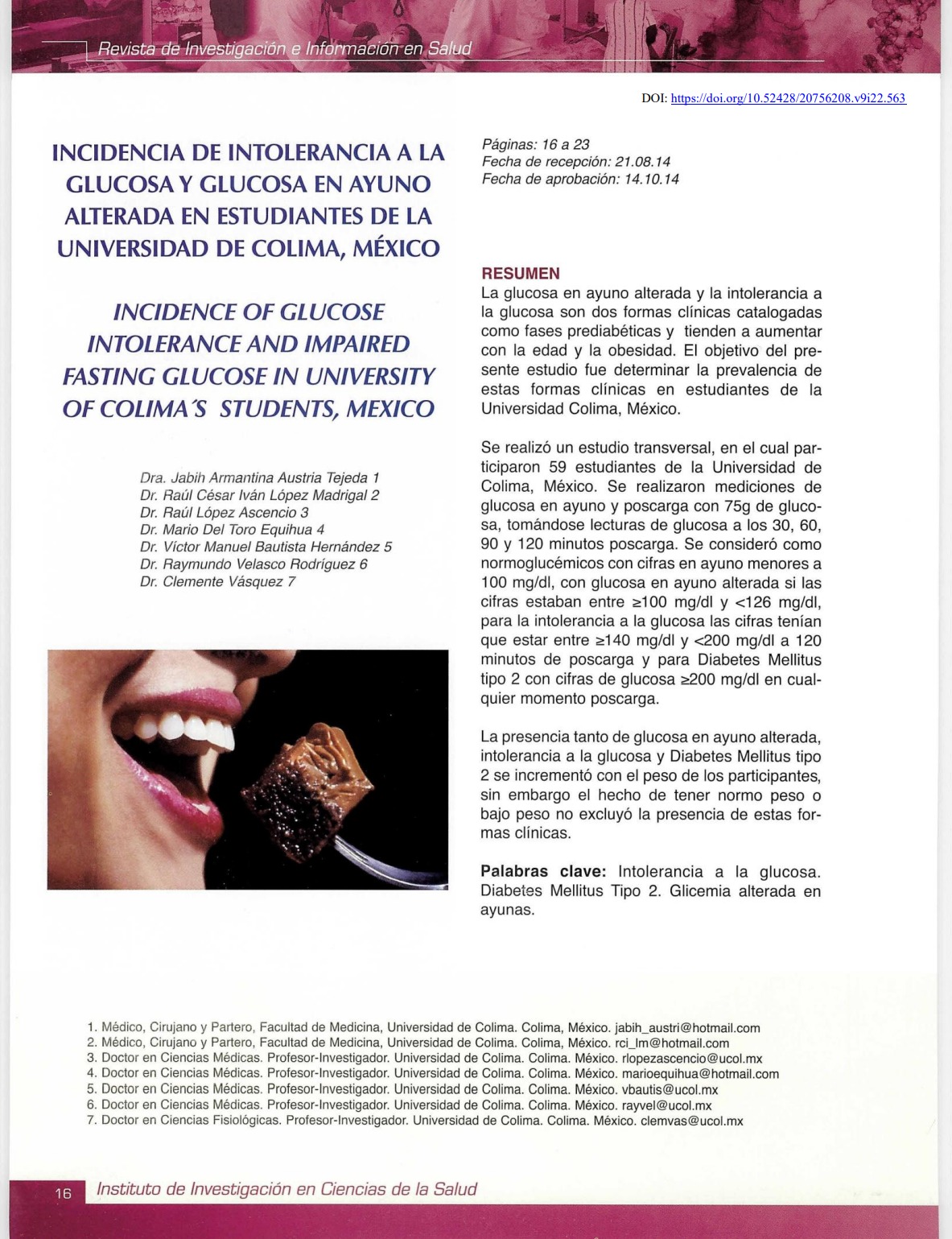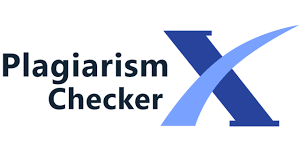Incidence of Glucose Intolerance and Impaired Fasting Glucose in University of Colimas Students, Mexico
DOI:
https://doi.org/10.52428/20756208.v9i22.563Keywords:
IGT, Type 2 Diabetes Mellitus, Impaired fasting glycemiaAbstract
Impaired fasting glucose and impaired glucose tolerance are two clinical forms classified as prediabetic stages and tend to increase with age and obesity. The aim of this study was to determine the prevalence of these clinical forms in Colima University's students, Mexico. A cross-sectional study, which involved 59 students from the University of Colima, Mexico was conducted. Glucose measurements were performed on fasting and afterload with 75g of glucose, glucose readings being taken at 30, 60, 90 and 120 minutes afterload. Normoglycemic figures were considered in Iower fasting 100 mg/dl, impaired fasting glucose if the figures were among >100 mg / dl and <126 mg / dl for glucose intolerance figures had to be between 140 mg / dl and <200 mg / dl to 120 minutes of afterload and type 2 Diabetes Mellitus with glucose levels mg / dl at any time afterload. The presence of impaired fasting glucose, impaired glucose tolerance and type 2 Diabetes Mellitus increased the weight of the participants, however having normal weight or underweight did not exclude the presence of these clinical forms.
Downloads
References
. Encuesta Nacional de Salud y Nutrición. Instituto Nacional de Salud. Secretaría de Salud, Gobierno Federal. 2006, México D.F.
AMERICAN DIABETES ASSOCIATION. Diagnosis and Classification of Diabetes Mellitus. Diabetes Care 2011; 34: S62- S69. https://doi.org/10.2337/dc11-S062
FEDERACIÓN INTERNACIONAL DE DIABETES. Diabetes y alteración de tolerancia a la glucosa, carga mundial: prevalencia y predicciones, 2010 y 2030. IDF Diabetes Atlas, lnternational Diabetes Federation, 2009 cuarta edición.
HARRIS R, DONAHUE K, RATHORE SS, FRAME P, WOOLF SH, LOHR KN. Screening Adults far Type
Diabetes: A Review of the Evidence far the U.S. Preventive Services Task Force. Ann lntern Med 2003; 138: 215-229. https://doi.org/10.7326/0003-4819-138-3-200302040-00015
ORGANIZACIÓN MUNDIAL DE LA SALUD. Tópicos en Salud. Diabetes. 2011.
ZEYDA, M, STULNIG TM. Obesity, lnflammation, and insulin resitance. A Mini-Review. Gerontology 2009; 55: 379-386. https://doi.org/10.1159/000212758
GUILHERME A, VIRBASIUS JV, PURI V, CZECH MP. Adipocyte dysfunctions linking obesity to insulin resistance and type 2 diabetes. Nat Rev Mol Cell Biol 2008; 9: 367-377. https://doi.org/10.1038/nrm2391
GUTIERREZ DA, PUGLISI MJ, HASY AH. lmpact of increased adipose tissue mass on inflammation, insulin resistance and dyslipidemia. Curren! Diab Rep 2009; 9: 26-32. https://doi.org/10.1007/s11892-009-0006-9
VÁZQUEZ CHÁVEZ C, SALINAS OROZCO S, MORENO VÁZQUEZ K, GÓMEZ DÍAZ RA, ROSSO JUÁREZ MM, JIMÉNEZ VILLARUEL M ET AL. Incidencia y factores de riesgo para desarrollo de intolerancia a la glucosa y Diabetes Mellitus tipo 2 en población mexicana previamente normoglucémica. Rev Endocrino! Nutr 2003; 1 1 : 28-33.
VELÁZQUEZ MONROY O, LARA ESQUEDA A, TAPIA CONYER R. Metfarmina y Síndrome Metabólico Manual de uso. 2002 Secretaria de Salud México; pp 2 -11.
HEMMINGSEN B, LUND SS, WETTERSLEV J, VAAG A. Oral hypoglycaemic agents, insulin resistance and cardiovascular disease in patients with type 2 diabetes. Eur J Endocrino! 2009; 161: 1-9. https://doi.org/10.1530/EJE-09-0167
DEFRONZO RA. lnsulin resistance, lipotoxicity, type 2 diabetes and atherosclerosis: the missing links. The Claude Bernard Lecture 2009. Diabetologia 201 O; 53: 1270-1287. https://doi.org/10.1007/s00125-010-1684-1
GENUTH S, ALBERTI KG, BENNETTP, BUSE J, DEFRONZO R, KAHN RETAL. Follow-up report on the diagnosis of Diabetes Mellitus. Diabetes Care 2003; 26: 3160-3167. https://doi.org/10.2337/diacare.26.11.3160
MUNGUÍA-MIRANDA C, SÁNCHEZ-BARRERA RG, TUZ K, ALONSO-GARCÍA AL, CRUZ M. Detección de glucosa en ayuno alterada en donadores de sangre. Rev Med lnst Mex Seguro Soc 2009; 47: 17-24.
PARRA ORTEGA 1, ESTRADA GÓMEZ RA, RODRÍGUEZ GALLEGOS AB, GUZMÁN GARCÍA MO, GARCÍA ALCALÁ H. La determinación de la glucosa en ayunas y a las 2 horas posterior a una carga de 75 g de glucosa anhidra incrementa el diagnóstico de Diabetes Mellitus e intolerancia a la glucosa. Med Univer 2006; 8: 148-151.
SINHA R, FISCH G, TEAGUE B, TAMBORLANE WV, BANYAS B, ALLEN K ET AL. Prevalence of impaired glucose tolerance among children and adolescents with marked obesity. N Engl J Med 2002; 346: 802-81 o. https://doi.org/10.1056/NEJMoa012578
HERDER e, SCHMITZ-BEUTING e, RATHMANN W, HAASTERT B, SCHMITZ-BEUTING J, SCHÁFER M ET AL. Prevalence of impaired glucose regulation in German school-leaving students. lnt J Obes (Lond). 2007; 31: 1086-1088. https://doi.org/10.1038/sj.ijo.0803620
ALATTAR A, AL-MAJED H, ALMUAILI T, ALMUTAIRI O, SHAGHOULI A, ALTORAH W. Prevalence of impaired glucose regulation in asymptomatic Kuwaiti young adults. Med Princ Pract. 2012; 21: 51-55. https://doi.org/10.1159/000330024
RODBARD HW, JELLINGER PS, DAVIDSON JA, EINHORN D, GARBER AJ, GRUNBERGER G ET AL. Statement by an American Association of Clinical Endocrinologists/ American College of Endocrinology consensus panel on type 2 Diabetes Mellitus: an algorithm for glycemic control. Endocr Pract 2009; 15: 540-559. https://doi.org/10.4158/EP.15.6.540
CHIARELLI F, MARCOVECCHIO ML. lnsulin resistance and obesity in childhood. Eur J Endocrino! 2008; 159: S67-S74. https://doi.org/10.1530/EJE-08-0245

Downloads
Published
How to Cite
Issue
Section
License
Copyright (c) 2014 Jabih Armantina Austria Tejeda , Raúl César Iván López Madrigal , Raúl López Ascencio , Mario Del Toro Equihua , Víctor Manuel Bautista Hernández , Raymundo Velasco Rodríguez y Clemente Vásquez

This work is licensed under a Creative Commons Attribution 4.0 International License.
Authors who publish with this journal agree to the following terms:
- Authors retain copyright and grant the journal right of first publication with the work simultaneously licensed under a Creative Commons Attribution License 4.0 that allows others to share the work with an acknowledgement of the work's authorship and initial publication in this journal.
- Authors are able to enter into separate, additional contractual arrangements for the non-exclusive distribution of the journal's published version of the work (e.g., post it to an institutional repository or publish it in a book), with an acknowledgement of its initial publication in this journal.
- Authors are permitted and encouraged to post their work online (e.g., in institutional repositories or on their website) prior to and during the submission process, as it can lead to productive exchanges, as well as earlier and greater citation of published work.






















